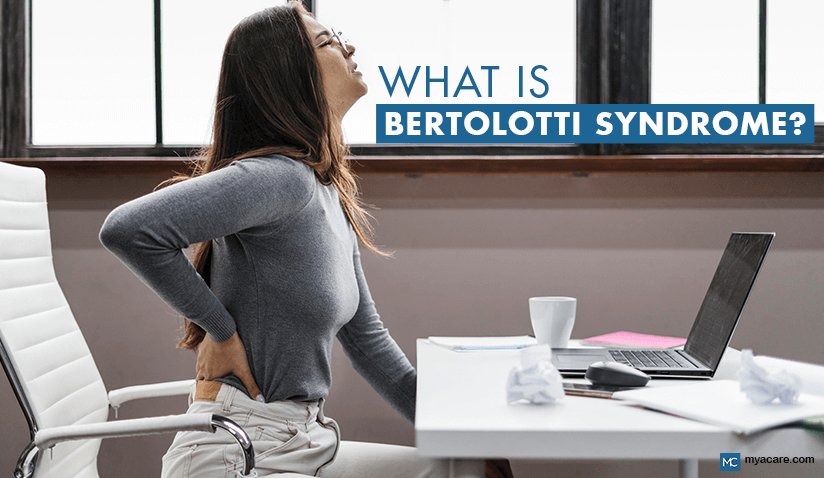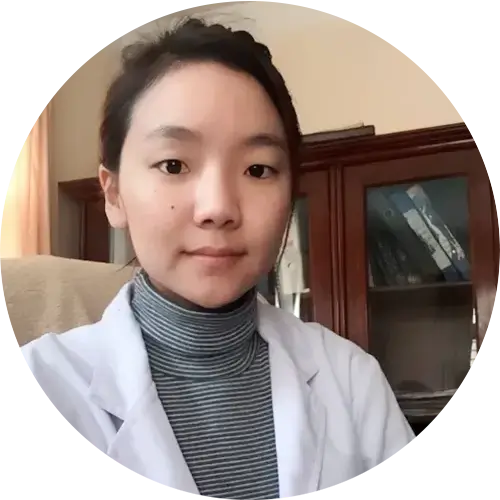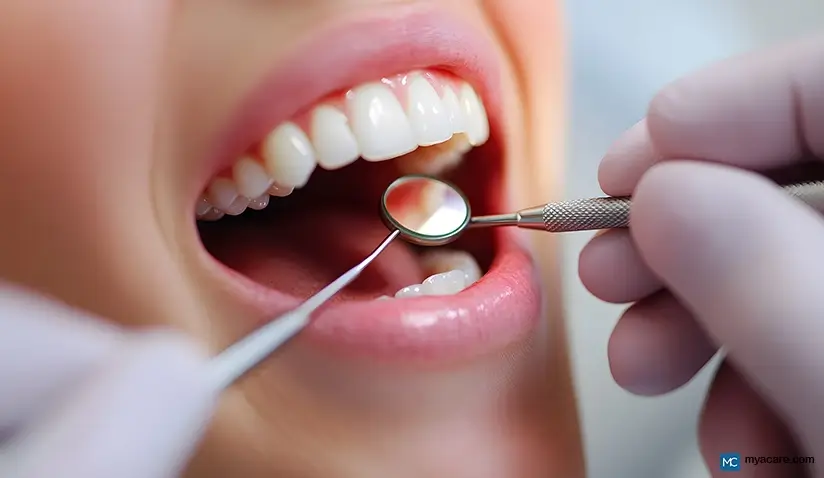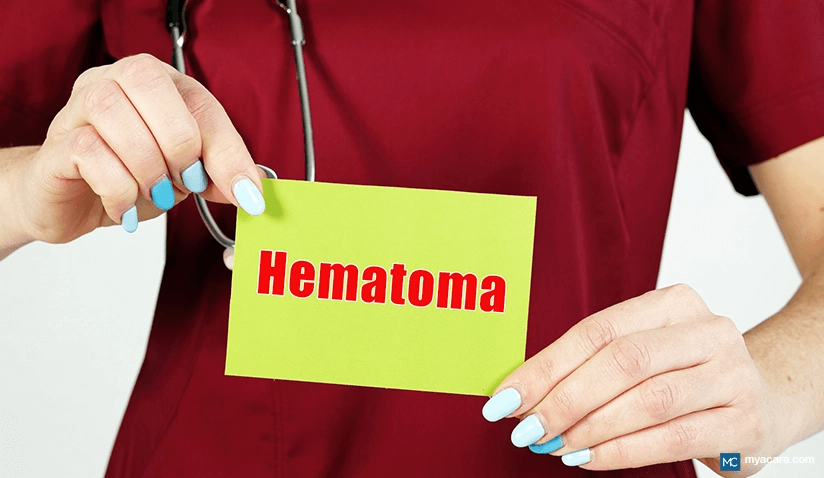Bertolotti Syndrome: A Commonly Overlooked Cause of Lower Back Pain

Medically Reviewed by Dr. Sony Sherpa, (MBBS)
Bertolotti’s Syndrome is a lesser-known cause of chronic lower back pain, often misdiagnosed as general musculoskeletal discomfort. It arises from an anatomical variation in the lower spine known as a lumbosacral transitional vertebra (LSTV), where the last lumbar vertebra (L5) abnormally fuses or forms an articulation with the sacrum or ilium. While this spinal variation is relatively common, it only leads to Bertolotti’s Syndrome when it causes pain and functional limitations.
Lower back pain affects millions worldwide, with causes ranging from muscle strain to degenerative conditions. As Bertolotti’s Syndrome shares symptoms with these conditions, it is frequently misdiagnosed, leading to prolonged discomfort and ineffective treatment. Some of the most common misdiagnoses include muscle strain, herniated discs, sciatica, and degenerative disc disease.
Many individuals with Bertolotti’s Syndrome undergo years of treatments, including physical therapy, medications, and even spinal surgeries, before receiving an accurate diagnosis.
Lumbosacral transitional vertebrae are a relatively common anatomical variation, occurring in 4–30% of the general population. However, only a small subset of people with LSTV develop symptoms. Those who do experience pain often begin noticing symptoms in late adolescence or early adulthood, coinciding with increased physical activity or spinal stress.
Despite its prevalence, Bertolotti’s Syndrome remains underdiagnosed because standard imaging, such as routine X-rays, may not always detect the condition unless a physician specifically looks for it. Advanced imaging techniques, including CT scans or MRI, may be necessary to confirm the diagnosis and differentiate it from other causes of chronic lower back pain.
Typical Anatomy of the Lower Spine
It is important to compare the typical anatomy of the lower spine affected by Bertolotti’s Syndrome with the normal anatomy to understand the condition.
- The lumbar spine (L1-L5) consists of five vertebrae that provide flexibility and support to the lower back.
- Under the lumbar spine is the sacrum, a triangular bone formed by five fused sacral vertebrae (S1-S5), which connects the spine to the pelvis.
- The L5-S1 junction is a critical point for movement, absorbing stress and facilitating motion between the lumbar spine and the sacrum.
In individuals with LSTV, the L5 vertebra does not function independently but instead partially or fully fuses with the sacrum or forms a pseudo-articulation with the ilium. This altered structure can lead to:
- Restricted mobility in the lower back
- Asymmetrical stress on the spine and pelvis
- Compression or irritation of nearby nerves
Bertolotti’s Syndrome occurs only when the anatomical abnormality leads to chronic pain or dysfunction. Symptom development may be linked to factors like:
- Altered spinal biomechanics, causing strain on surrounding muscles and joints.
- Nerve compression or irritation, leading to pain that radiates into the hips or legs.
- Inflammation at the pseudo-joint (pseudo-articulation) between L5 and the sacrum or ilium.
Since LSTV is often discovered incidentally on imaging scans, it is important to distinguish between individuals who have the anatomical variation without symptoms and those who develop Bertolotti’s Syndrome with chronic pain and discomfort.
What Causes Bertolotti’s Syndrome?
Bertolotti’s Syndrome is a congenital spinal condition, meaning it is present from birth.
The exact genetic basis of Bertolotti’s Syndrome is not well established, but studies suggest that congenital vertebral anomalies can have a hereditary component. Some families have shown a higher prevalence of LSTV, indicating a possible genetic link. However, more research is needed to determine the specific genes involved.
What Is Pseudo-Articulation in Bertolotti Syndrome?
In some cases, instead of a complete fusion between L5 and the sacrum, a pseudo-articulation (false joint) forms between the enlarged transverse process of L5 and the sacrum or ilium. This pseudo-joint can cause inflammation, pain, and limited mobility, especially when it undergoes repetitive stress. Unlike normal joints, pseudo-articulations lack proper cushioning or cartilage, making them more susceptible to irritation and discomfort.
What Triggers Pain in Bertolotti’s Syndrome?
While LSTV is present at birth, pain may not develop until adolescence or early adulthood, when physical activity increases. Certain factors can contribute to its onset, which are listed as follows:
- Repetitive stress or mechanical strain on the pseudo-joint.
- Minor trauma that aggravates the transitional vertebra.
- Altered spinal biomechanics, leading to increased pressure on adjacent discs and joints.
- Compensatory changes in posture or movement, placing stress on surrounding structures.
Castellvi and Jenkins Classifications of LSTV
Castellvi’s classification is the most widely used system to categorize LSTV:
- Type I – Unilateral (Ia) or bilateral (Ib) enlarged transverse process (>19mm) without articulation.
- Type II – Pseudo-articulation of L5 transverse process with the sacrum or ilium, unilateral (IIa) or bilateral (IIb).
- Type III – Complete fusion of the L5 transverse process with the sacrum or ilium, unilateral (IIIa) or bilateral (IIIb).
- Type IV – A combination of Type II on one side and Type III on the other.
Jenkins classification
It divides LSTV into:
- Complete fusion (sacralization).
- Partial fusion (pseudo-articulation).
- Unilateral vs. bilateral involvement.
These classifications help guide diagnosis and treatment, as certain types (e.g., Type II with pseudo-articulation) are more likely to cause symptoms than others.
Bertolotti Syndrome Symptoms
The symptoms of Bertolotti Syndrome can vary widely from person to person. These could be listed as follows:
Common Symptoms
- Chronic lower back pain, often localized to one side.
- Pain that radiates to the buttock, hip, or leg, sometimes mimicking sciatica.
- Increased pain with certain movements, such as:
- Bending forward or backward.
- Twisting the spine.
- Prolonged standing or sitting.
- Lower back stiffness, especially after periods of inactivity.
- Tingling or numbness, particularly if nerve compression occurs.
- Symptoms may start in adolescence or young adulthood, often worsening over time.
Asymptomatic Cases
Many people with lumbosacral transitional vertebrae never experience pain or discomfort. Their condition is often discovered accidentally when undergoing imaging (X-ray, MRI) for an unrelated issue. The presence of an LSTV alone does not automatically mean a person has Bertolotti Syndrome - it only becomes a syndrome when it causes pain and functional limitations.
What Is Bertolotti Syndrome Associated With?
In some cases, Bertolotti Syndrome has been linked to other congenital conditions that affect the spine and connective tissues, such as:
- Congenital Cervical Stenosis – A narrowing of the spinal canal in the neck, which may cause nerve compression and neurological symptoms.
- Ehlers-Danlos Syndrome (EDS), Hypermobility Type – A connective tissue disorder that leads to joint hypermobility, chronic pain, and musculoskeletal instability.
These associations suggest that individuals with Bertolotti Syndrome may have an underlying predisposition to spinal abnormalities or altered biomechanics, making them more prone to chronic pain conditions.
Diagnosis of Bertolotti Syndrome
Diagnosing Bertolotti Syndrome requires a thorough clinical evaluation and imaging studies to differentiate it from other common causes of lower back pain. Since it is often misdiagnosed, proper identification of lumbosacral transitional vertebrae is crucial for targeted treatment.
Medical History and Physical Examination
A doctor will begin by:
- Asking about symptoms, their onset, and any triggering factors (e.g., prolonged standing, twisting, or bending).
- Checking for localized tenderness in the lower back, particularly around the L5-S1 region.
- Assessing the range of motion and identifying movements that worsen the pain.
- Evaluating for neurological signs such as tingling, numbness, or weakness in the legs.
Imaging Studies
To confirm the presence of an LSTV and rule out other conditions, imaging tests are necessary:
- X-rays – The first-line imaging test to identify an abnormally shaped transverse process, pseudo-articulations, or partial sacral fusion.
- CT scan – Provides more detailed images of bone structures, helping classify the type of LSTV using Castellvi classification.
- MRI – Assesses soft tissues, nerve involvement, and disc degeneration that may contribute to pain. It also helps rule out herniated discs and other spinal conditions.
Differentiating Bertolotti Syndrome from Other Causes of Back Pain
Since chronic lower back pain is a common complaint, it is essential to distinguish Bertolotti Syndrome from other spinal disorders, such as:
- Herniated Disc – Involves disc material pressing on nerves, typically causing bilateral pain and nerve symptoms. Bertolotti Syndrome usually affects one side.
- Sciatica – Causes sharp, radiating pain down the leg due to nerve compression, which can also occur in Bertolotti Syndrome if nerves are irritated.
- Degenerative Disc Disease – Related to age-related wear and tear, whereas Bertolotti Syndrome is congenital.
Bertolotti Syndrome vs. Sacralization
Sacralization refers to the complete fusion of L5 with the sacrum, forming a solid bone structure. Bertolotti Syndrome typically involves partial fusion or pseudo-articulation, which can create a painful, unstable joint. While sacralization may not always cause symptoms, Bertolotti Syndrome leads to localized pain and movement restrictions due to the pseudo-joint.
Bertolotti Syndrome and Sacroiliitis
Sacroiliitis is inflammation of the sacroiliac (SI) joint, often causing pain in the lower back and buttocks. Bertolotti Syndrome can sometimes mimic sacroiliitis due to pain near the sacroiliac joint. A key difference is that sacroiliitis is usually linked to autoimmune conditions (e.g., ankylosing spondylitis), while Bertolotti Syndrome is structural in nature.
Bertolotti’s Syndrome Treatment
Treatment for Bertolotti Syndrome focuses on pain relief and functional improvement, as the condition itself is congenital and cannot be reversed. Conservative treatment is the first-line approach, while surgery is considered only if symptoms persist despite non-surgical management.
Conservative Treatment
Most cases of Bertolotti Syndrome can be managed effectively with non-invasive treatments, including:
Pain Management
- Nonsteroidal Anti-Inflammatory Drugs (NSAIDs) – Help reduce inflammation and pain in the affected area.
- Muscle Relaxants – May be prescribed for associated muscle spasms that contribute to discomfort.
- Physical Therapy – Strengthens the core and lower back muscles to support the spine, reducing strain on the affected vertebra. Pilates-based therapy has shown promise in managing chronic lower back pain.
Local Injections
- Corticosteroid Injections – Reduce inflammation and pain by targeting the pseudo-articulation or inflamed surrounding tissues.
- Local Anesthetic Injections – Can provide short-term pain relief and help confirm the diagnosis if the pain originates from the transitional vertebra.
Manual Therapy
- Chiropractic Care and Osteopathic Manipulation – Some patients report relief with spinal adjustments and soft tissue mobilization. However, care should be taken as aggressive manipulation may worsen symptoms.
Surgical Treatment
Surgical treatment for Bertolotti Syndrome includes resection, nerve root decompression, and spinal fusion, classified into traditional microscopic and advanced endoscopic techniques.
Microscopic Surgery
Resection
This procedure is most effective for type II Lumbosacral Transitional Vertebra (LSTV) with pseudo-articulations causing pain. The surgery involves removing the abnormal connection between the LSTV and sacrum, potentially relieving stress on adjacent joints. However, increased segmental motion post-resection may worsen disc-related pain. A diagnostic block before surgery helps pinpoint the pain source. Techniques include:
- Pseudo-articulation Resection: Directly removes the pain-causing tissue, requiring precise identification of the pseudo-articulation to avoid excessive tissue removal.
- Transverse Processectomy: Less invasive, this technique removes only the transverse process (the bony projection on either side of a vertebra that serves as an attachment point for muscles and ligaments) to reduce mechanical stress, though it may be less effective for pain relief and carries a risk of symptom recurrence.
- Anterior Approach: Accesses the pseudo-articulation through an anterior incision, minimizing disruption to posterior structures. It is suitable for anteriorly located pseudo-articulations but requires surgical expertise due to the risk of damaging nearby organs and vessels.
Nerve Root Decompression
This procedure is performed when L5 nerve root compression occurs due to far-out syndrome, where the L5 root is squeezed between the TP and sacral ala. Partial resection of these structures relieves pressure, typically using a posterior approach. In rare cases, an anterior approach may be chosen if bony spurs compress the nerve.
Fusion
Fusion is reserved for cases where discogenic pain coexists or when resection alone cannot alleviate symptoms. The procedure involves stabilizing the LSTV and adjacent segments with pedicle screws and intersegmental fusion. While more invasive, fusion can offer better long-term pain relief, especially when adjacent segment degeneration is present.
Endoscopic Surgery
Full Endoscopy
Offers a less invasive approach with outcomes comparable to conventional surgery.
- Nerve Root Decompression: This involves removing parts of the transverse process (TP) and pseudo-articulation, preserving the iliolumbar ligament. It has good long-term outcomes.
- Pseudo-articulation Resection: This involves a 1-cm incision to drill from the pseudo-articulation's ventrolateral margin to the medio-inferior margin, ensuring a 9-mm gap between the TP and sacral alar to prevent recurrence. Extensive resection has been linked to better pain relief.
- Transverse Processectomy: This is done by drilling the L5 transverse process base, blocking mechanical stress, and decompressing the L5 root. This method combines the benefits of transverse processectomy with full endoscopy.
Unilateral Biportal Endoscopy (UBE)
This method has been found to have shorter operation times, less blood loss, reduced postoperative pain, and quicker recovery. The technique involves two small incisions to create separate endoscopic and working channels, drilling out the pseudo-articulation while decompressing the L5 root. Drawbacks include a steep learning curve, potential incomplete decompression, and retroperitoneal fluid collection.
Bertolotti Syndrome Surgery Recovery Time
- Recovery time varies based on the type of procedure.
- In the case of resection, most patients recover within 6-8 weeks, with a gradual return to normal activities.
- For spinal fusion, recovery can take several months, with physical therapy required for optimal function.
Living with Bertolotti Syndrome
Managing Bertolotti Syndrome requires a combination of physical therapy, lifestyle modifications, and pain management methods to help improve quality of life and manage chronic symptoms. While the condition cannot be completely reversed, a proactive approach can significantly reduce discomfort and improve overall well-being.
Importance of Physical Therapy and Exercise
One of the most effective ways to manage Bertolotti Syndrome is through physical therapy and exercise, which help strengthen the muscles around the lower back, providing better support for the spine. Stronger muscles can reduce the strain placed on the lumbosacral junction, potentially alleviating pain and preventing further injury.
Recommended Exercises
- Core strengthening exercises: These include planks, bridges, and abdominal exercises that help stabilize the spine and reduce the pressure on the transitional vertebra.
- Stretching exercises: Hamstring and hip flexor stretches help maintain flexibility and avoid tightness that could exacerbate pain.
- Low-impact aerobic exercises: Activities like walking, swimming, or cycling are beneficial for overall spine health without putting too much stress on the lower back.
Exercises to Avoid with Bertolotti Syndrome
While exercise is beneficial, certain exercises and activities can stress the lower back excessively and aggravate symptoms. It is essential to avoid:
High-Impact Activities
- Running on hard surfaces: High-impact activities, such as running on concrete, can cause shockwaves through the spine and worsen pain.
- Jumping exercises: Exercises that involve a lot of jumping or sudden movements can strain the lower back.
Twisting Movements
- Rotational sports or exercises: Movements like twisting in golf, tennis, or even bending or twisting motions during everyday activities can irritate the affected area.
Heavy Lifting
- Avoid lifting heavy weights that can strain the lower back. If lifting is necessary, always bend at the knees and use proper lifting techniques to protect your spine.
Lifestyle Modifications
Apart from physical therapy, lifestyle changes can be crucial for managing symptoms and avoiding flare-ups.
Proper Posture
Maintaining good posture is essential for minimizing the strain on the lower back. Poor posture can worsen the symptoms of Bertolotti Syndrome by misaligning the spine and putting additional stress on the affected vertebrae.
- Standing: Keep your shoulders back, hips aligned, and avoid slouching.
- Sitting: Ensure that your feet are flat on the floor and your back is supported by a chair with lumbar support.
- Sleeping: Use a mattress that offers adequate support, and avoid sleeping on your stomach.
Ergonomic Workspace
Many people with Bertolotti Syndrome experience worsening pain from prolonged sitting or poor posture at work.
- Ergonomic chair: Select a chair that supports your spine’s natural curvature, with adjustable height and backrest.
- Desk height: Ensure that your workstation is at eye level to refrain from straining your neck and back.
- Take breaks: Stand up, stretch, and walk around every 30 minutes to prevent stiffness.
Pain Management Techniques
Managing chronic pain is critical for those living with Bertolotti Syndrome. Besides physical therapy and exercise, several pain management strategies can help alleviate discomfort:
Heat and Cold Therapy
- Heat: A warm compress or heating pad applied to the lower back can promote muscle relaxation and improve circulation, reducing stiffness and pain.
- Cold: An ice pack or cold compress can help reduce inflammation and numb pain, especially during flare-ups.
Stress Management
Stress can exacerbate muscle tension, worsening pain and discomfort. Managing stress is essential for long-term well-being. Techniques include:
- Mindfulness and meditation: Relaxation practices help reduce the body’s stress response and can reduce pain sensitivity.
- Deep breathing exercises: Can help soothe the nervous system and improve overall pain tolerance.
- Yoga or Tai Chi: Low-impact exercises that focus on breathing, flexibility, and strength can be beneficial for managing stress and maintaining a healthy spine.
When to See a Doctor
It is crucial to seek medical attention for persistent or severe lower back pain, especially if the pain is affecting daily activities or does not improve with home remedies. Bertolotti Syndrome can often be misdiagnosed as general back pain; consulting a healthcare professional ensures a proper evaluation, accurate diagnosis, and treatment plan. If you encounter symptoms such as radiating pain, numbness, or weakness in the legs, medical attention is necessary. Early intervention can help avert further complications and provide relief from symptoms.
Latest Research and Advancements
Recent advancements in the understanding and treatment of Bertolotti Syndrome have led to emerging options for managing symptoms. While conservative modalities such as physical therapy and injections remain the first-line approach, there are innovations on the horizon.
- Regenerative Treatments: Research into platelet-rich plasma (PRP) therapy and prolotherapy has shown promise in repairing soft tissue injuries and reducing pain. These treatments aim to enhance the body's healing response and potentially reduce reliance on more invasive treatments.
- Minimally Invasive Procedures: Advancements in minimally invasive spinal surgery are providing new treatment options for individuals who do not respond to conservative methods. Procedures like radiofrequency ablation (RFA) have shown the potential to reduce pain and improve mobility with less recovery time compared to traditional spinal surgeries.
- Stem Cell Therapy: Emerging research suggests that stem cell therapy could potentially repair damaged spinal structures and promote healing in the affected area, although it is still under investigation.
Frequently Asked Questions
Is Bertolotti Syndrome Arthritis?
No, Bertolotti Syndrome is not classified as arthritis. It is an anatomical variation of the spine, where a transitional vertebra forms between the lumbar and sacral spine. This condition can cause lower back pain, but it does not involve joint inflammation or damage characteristic of arthritis.
Can Bertolotti's Syndrome Cause Ankylosing Spondylitis?
There is no direct connection between Bertolotti Syndrome and ankylosing spondylitis. The latter is a type of inflammatory arthritis that affects the spine, while the former is a structural variation, not an inflammatory condition. However, the pain associated with Bertolotti Syndrome can sometimes overlap with symptoms of other spinal conditions, so it is important to have a thorough evaluation.
Is Bertolotti Syndrome Considered a Disability?
Bertolotti Syndrome in itself is not automatically considered a disability. However, if the condition leads to chronic pain or severe impairment in mobility, it may impact a person’s ability to work or perform daily activities.
Does Bertolotti Syndrome Cause Scoliosis?
Bertolotti Syndrome does not directly cause scoliosis, which is a condition characterized by an abnormal curvature of the spine. However, in some cases, the pain or structural changes in the spine due to Bertolotti Syndrome may lead to compensatory postural changes, which could resemble scoliosis. It is important to differentiate between the two conditions through medical imaging.
To search for the best Orthopedics Healthcare Providers in Croatia, Germany, India, Malaysia, Singapore, Spain, Thailand, Turkey, the UAE, UK and the USA, please use the Mya Care search engine.
To search for the best healthcare providers worldwide, please use the Mya Care search engine.
The Mya Care Editorial Team comprises medical doctors and qualified professionals with a background in healthcare, dedicated to delivering trustworthy, evidence-based health content.
Our team draws on authoritative sources, including systematic reviews published in top-tier medical journals, the latest academic and professional books by renowned experts, and official guidelines from authoritative global health organizations. This rigorous process ensures every article reflects current medical standards and is regularly updated to include the latest healthcare insights.

Dr. Sony Sherpa completed her MBBS at Guangzhou Medical University, China. She is a resident doctor, researcher, and medical writer who believes in the importance of accessible, quality healthcare for everyone. Her work in the healthcare field is focused on improving the well-being of individuals and communities, ensuring they receive the necessary care and support for a healthy and fulfilling life.
References:
Featured Blogs



